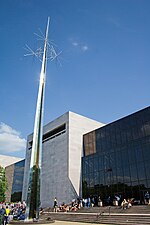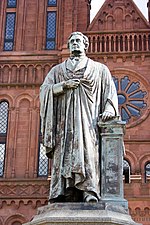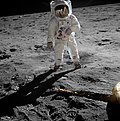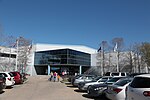Search results
There is a page named "Smithsonian Air and Space Museum" on Wikipedia)
 Air and Space Museum (NASM) of the Smithsonian Institution, is a museum in Washington, D.C., in the United States dedicated to human flight and space...49 KB (4,612 words) - 22:28, 23 April 2024
Air and Space Museum (NASM) of the Smithsonian Institution, is a museum in Washington, D.C., in the United States dedicated to human flight and space...49 KB (4,612 words) - 22:28, 23 April 2024- Air & Space/Smithsonian is a quarterly magazine published by the National Air and Space Museum in Washington, D.C., United States. Its first publication...3 KB (142 words) - 18:05, 1 April 2024
 The Smithsonian museums are the most widely visible part of the United States' Smithsonian Institution and consist of 20 museums and galleries as well...31 KB (1,144 words) - 22:33, 19 November 2023
The Smithsonian museums are the most widely visible part of the United States' Smithsonian Institution and consist of 20 museums and galleries as well...31 KB (1,144 words) - 22:33, 19 November 2023 Apollo 11 (section Launch and flight to lunar orbit)Smithsonian National Air and Space Museum. Archived from the original on July 20, 2019. Retrieved August 27, 2017. "Museum in DC". Smithsonian Air and...184 KB (19,447 words) - 00:54, 11 April 2024
Apollo 11 (section Launch and flight to lunar orbit)Smithsonian National Air and Space Museum. Archived from the original on July 20, 2019. Retrieved August 27, 2017. "Museum in DC". Smithsonian Air and...184 KB (19,447 words) - 00:54, 11 April 2024- Night at the Museum: Battle of the Smithsonian (also known as Night at the Museum 2: Battle of the Smithsonian or just Night at the Museum 2) is a 2009...36 KB (3,584 words) - 07:18, 15 April 2024
- Smithsonian Institution includes aircraft exhibited in the Smithsonian Institution's National Air and Space Museum, Steven F. Udvar-Hazy Center, and the...89 KB (6,970 words) - 02:18, 21 April 2024
- Museum, Greenwood Shearwater Aviation Museum, Shearwater Canada Aviation and Space Museum, Ottawa Canadian Air and Space Conservancy, Edenvale Canadian Bushplane...75 KB (5,787 words) - 01:24, 25 April 2024
- Space Center Houston finished 10th among 13 museums competing for the three orbiters (not already committed to the Smithsonian Air and Space Museum)...14 KB (1,377 words) - 11:58, 17 April 2024
 their 1908 and 1909 public demonstrations. The Smithsonian Institution's National Air and Space Museum refers to "The Wilbur Method" and "The Orville...12 KB (1,400 words) - 22:08, 2 January 2024
their 1908 and 1909 public demonstrations. The Smithsonian Institution's National Air and Space Museum refers to "The Wilbur Method" and "The Orville...12 KB (1,400 words) - 22:08, 2 January 2024 Endeavour and then Atlantis. The shuttle is now on display at the Steven F. Udvar-Hazy Center of the Smithsonian National Air and Space Museum. The name...45 KB (2,270 words) - 12:48, 11 March 2024
Endeavour and then Atlantis. The shuttle is now on display at the Steven F. Udvar-Hazy Center of the Smithsonian National Air and Space Museum. The name...45 KB (2,270 words) - 12:48, 11 March 2024- Space Test". Los Angeles Times. July 18, 1989. "Neutral Particle Beam Accelerator, Beam Experiment Aboard Rocket". Smithsonian Air and Space Museum....7 KB (801 words) - 09:11, 19 February 2024
 Steven F. Udvar-Hazy Center (category Smithsonian Institution museums)Udvar-Hazy Center, also called the Udvar-Hazy Center, is the Smithsonian National Air and Space Museum (NASM)'s annex at Washington Dulles International Airport...22 KB (2,125 words) - 17:13, 23 April 2024
Steven F. Udvar-Hazy Center (category Smithsonian Institution museums)Udvar-Hazy Center, also called the Udvar-Hazy Center, is the Smithsonian National Air and Space Museum (NASM)'s annex at Washington Dulles International Airport...22 KB (2,125 words) - 17:13, 23 April 2024 Apollo 15 (section Space suits)8, 2019. Mission Report, p. 3. "Apollo 15 Command Module". Smithsonian Air and Space Museum. March 17, 2016. Archived from the original on July 22, 2019...103 KB (11,346 words) - 11:15, 20 March 2024
Apollo 15 (section Space suits)8, 2019. Mission Report, p. 3. "Apollo 15 Command Module". Smithsonian Air and Space Museum. March 17, 2016. Archived from the original on July 22, 2019...103 KB (11,346 words) - 11:15, 20 March 2024- Smithsonian Affair)World War II, the Atomic Bomb and the Cold War, was drafted by the Smithsonian's National Air and Space Museum staff, and arranged around the restored...48 KB (4,939 words) - 21:57, 22 April 2024
- Peter Lloyd (illustrator) (category American album-cover and concert-poster artists)director for the 1995 film 500 Nations, and later worked extensively with the Smithsonian Air and Space Museum on the 1996 IMAX documentary Cosmic Voyage...3 KB (243 words) - 04:25, 14 April 2024
 Lunar Module Eagle (category Individual space vehicles)Retrieved October 22, 2021. "Location of Apollo Lunar Modules". Smithsonian Air and Space Museum. Archived from the original on July 26, 2020. Retrieved September...7 KB (553 words) - 04:54, 25 February 2024
Lunar Module Eagle (category Individual space vehicles)Retrieved October 22, 2021. "Location of Apollo Lunar Modules". Smithsonian Air and Space Museum. Archived from the original on July 26, 2020. Retrieved September...7 KB (553 words) - 04:54, 25 February 2024
- 1896 (1896) The Smithsonian Institution II by Henry Carrington Bolton 1231888Popular Science Monthly Volume 48 February 1896 — The Smithsonian Institution
- exhibition at the Museum of Modern Art. 'Oral history interview with Edward Hopper', 1959 June 17, Archives of American Art, Smithsonian Institution, interviewer
- Modern Airport. (2007). Smithsonian National Air and Space Museum. Retrieved from https://airandspace.si.edu/exhibitions/america-by-air/online/innovation/innovation10












